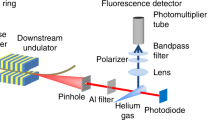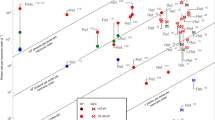Abstract
Quantum coherent control1,2,3,4,5,6 is a powerful tool for steering the outcome of quantum processes towards a desired final state by the accurate manipulation of quantum interference between multiple pathways. Although coherent control techniques have found applications in many fields of science7,8,9,10,11,12, the possibilities for spatial and high-resolution frequency control have remained limited. Here, we show that the use of counter-propagating broadband pulses enables the generation of fully controlled spatial excitation patterns. This spatial control approach also provides decoherence reduction, which allows the use of the high-frequency resolution of an optical frequency comb13,14. We exploit the counter-propagating geometry to perform spatially selective excitation of individual species in a multicomponent gas mixture, as well as frequency determination of hyperfine constants of atomic rubidium with unprecedented accuracy. The combination of spectral and spatial coherent control adds a new dimension to coherent control, with applications in nonlinear spectroscopy, microscopy and high-precision frequency metrology, among others.
This is a preview of subscription content, access via your institution
Access options
Subscribe to this journal
Receive 12 print issues and online access
$209.00 per year
only $17.42 per issue
Buy this article
- Purchase on Springer Link
- Instant access to full article PDF
Prices may be subject to local taxes which are calculated during checkout




Similar content being viewed by others
References
Warren, W. S., Rabitz, H. & Dahleh, M. Coherent control of quantum dynamics: the dream is alive. Science 259, 1581–1589 (1993).
Weiner, A. M., Leaird, D. E., Wiederrecht, G. P. & Nelson, K. A. Femtosecond pulse sequences used for optical manipulation of molecular motion. Science 247, 1317–1319 (1990).
Silberberg, Y. Quantum coherent control for nonlinear spectroscopy and microscopy. Annu. Rev. Phys. Chem. 60, 277–292 (2009).
Brif, C., Chakrabarti, R. & Rabitz, H. Control of quantum phenomena: past, present and future. New J. Phys. 12, 075008 (2010).
Broers, B., van Linden van den Heuvell, H. B. & Noordam, L. D. Large interference effects of small chirp observed in two-photon absorption. Opt. Commun. 91, 57–61 (1992).
Chatel, B., Degert, J., Stock, S. & Girard, B. Competition between sequential and direct paths in a two-photon transition. Phys. Rev. A 68, 041402 (2003).
Bartels, R. et al. Shaped-pulse optimization of coherent emission of high-harmonic soft X-rays. Nature 406, 164–166 (2000).
Dela Cruz, J. M., Pastirk, I., Comstock, M., Lozovoy, V. V. & Dantus, M. Use of coherent control methods through scattering biological tissue to achieve functional imaging. Proc. Natl Acad. Sci. USA 101, 16996–17001 (2004).
Papagiakoumou, E. et al. Scanless two-photon excitation of channelrhodopsin-2. Nature Methods 7, 848–854 (2010).
Prokhorenko, V. I. et al. Coherent control of retinal isomerization in bacteriorhodopsin. Science 313, 1257–1261 (2006).
Herek, J. L., Wohlleben, W., Cogdell, R. J., Zeidler, D. & Motzkus, M. Quantum control of energy flow in light harvesting. Nature 417, 533–535 (2002).
Nuernberger, P., Wolpert, D., Weiss, H. & Gerber, G. Femtosecond quantum control of molecular bond formation. Proc. Natl Acad. Sci. USA 107, 10366–10370 (2010).
Holzwarth, R. et al. Optical frequency synthesizer for precision spectroscopy. Phys. Rev. Lett. 85, 2264–2267 (2000).
Jones, D. J. et al. Carrier-envelope phase control of femtosecond mode-locked lasers and direct optical frequency synthesis. Science 288, 635–639 (2000).
Weiner, A. M. Femtosecond pulse shaping using spatial light modulators. Rev. Sci. Instrum. 71, 1929–1960 (2000).
Stowe, M. C., Pe'er, A. & Ye, J. Control of four-level quantum coherence via discrete spectral shaping of an optical frequency comb. Phys. Rev. Lett. 100, 203001 (2008).
Meshulach, D. & Silberberg, Y. Coherent quantum control of two-photon transitions by a femtosecond laser pulse. Nature 396, 239–242 (1998).
Hänsch, T. W., Harvey, K. C., Meisel, G. & Schawlow, A. L. Two-photon spectroscopy of Na 3s–4d without Doppler broadening using a CW dye laser. Opt. Commun. 11, 50–53 (1974).
Levenson, M. D. & Bloembergen, N. Observation of two-photon absorption without Doppler broadening on the 3S–5S transition in sodium vapor. Phys. Rev. Lett. 32, 645–648 (1974).
Witte, S., Zinkstok, R. Th., Ubachs, W., Hogervorst, W. & Eikema, K. S. E. Deep-ultraviolet quantum interference metrology with ultrashort laser pulses. Science 307, 400–403 (2005).
Marian, A., Stowe, M. C., Lawall, J. R., Felinto, D. & Ye, J. United time-frequency spectroscopy for dynamics and global structure. Science 306, 2063–2068 (2004).
Wolf, A. L., van den Berg, S. A., Ubachs, W. & Eikema, K. S. E. Direct frequency comb spectroscopy of trapped ions. Phys. Rev. Lett. 102, 223901 (2009).
Gerginov, V., Tanner, C. E., Diddams, S. A., Bartels, A. & Hollberg L. High-resolution spectroscopy with a femtosecond laser frequency comb. Opt. Lett. 30, 1734–1736 (2005).
Marian, A., Stowe, M. C., Felinto, D. & Ye, J. Direct frequency comb measurements of absolute optical frequencies and population transfer dynamics. Phys. Rev. Lett. 95, 023001 (2005).
Ozawa, A. & Kobayashi, Y. Chirped-pulse direct frequency-comb spectroscopy of two-photon transitions. Phys. Rev. A 86, 022514 (2012).
Chui, H. C. et al. Absolute frequency measurement of rubidium 5S–7S two-photon transitions with a femtosecond laser comb. Opt. Lett. 30, 842–844 (2005).
Cundiff, S. T. & Weiner, A. M. Optical arbitrary waveform generation. Nature Photon. 4, 760–766 (2010).
Kirchner, M. S. & Diddams, S. A. Grism-based pulse shaper for line-by-line control of more than 600 optical frequency comb lines. Opt. Lett. 35, 3264–3266 (2010).
Acknowledgements
S.W. acknowledges support from the Netherlands Organization for Scientific Research (NWO Veni grant 680-47-402). K.S.E.E. acknowledges support from the NWO (VICI grant no. 680-47-310), the Foundation for Fundamental Research on Matter (FOM) through its programme ‘Broken Mirrors and Drifting Constants’, and Laserlab Europe (JRA ALADIN and INREX). The authors thank M. Sheinman for helpful discussions in the development of the theoretical model.
Author information
Authors and Affiliations
Contributions
K.S.E.E. conceived the V-shape phase concept for frequency comb spectroscopy. I.B. extended this concept to full spatial coherent control and provided the theoretical description. I.B. performed the experiments (with assistance from S.W and K.S.E.E.) and data analysis. K.S.E.E. supervised the project. All authors participated in the design of the experiments, interpretation of the results and writing of the manuscript.
Corresponding author
Ethics declarations
Competing interests
The authors declare no competing financial interests.
Supplementary information
Supplementary information
Supplementary information (PDF 731 kb)
Rights and permissions
About this article
Cite this article
Barmes, I., Witte, S. & Eikema, K. Spatial and spectral coherent control with frequency combs. Nature Photon 7, 38–42 (2013). https://doi.org/10.1038/nphoton.2012.299
Received:
Accepted:
Published:
Issue Date:
DOI: https://doi.org/10.1038/nphoton.2012.299
This article is cited by
-
Real-time phase tracking for wide-band optical frequency measurements at the 20th decimal place
Nature Photonics (2020)
-
Frequency comb spectroscopy
Nature Photonics (2019)
-
Programmable broadband optical field spectral shaping with megahertz resolution using a simple frequency shifting loop
Nature Communications (2019)
-
Spatial beam self-cleaning in multimode fibres
Nature Photonics (2017)
-
Direct frequency comb optical frequency standard based on two-photon transitions of thermal atoms
Scientific Reports (2015)



